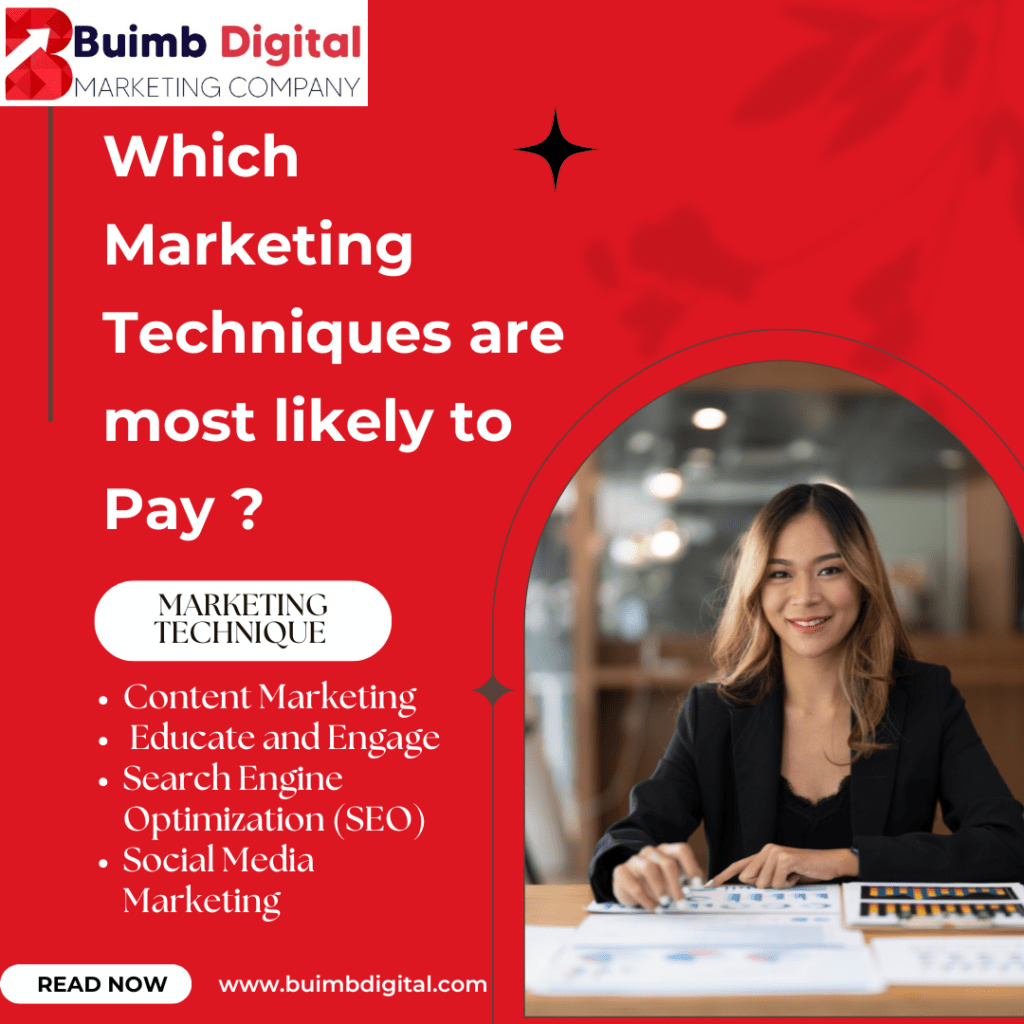Which marketing techniques are most likely to Pay ?
In the ever-evolving landscape of marketing, businesses are constantly seeking strategies that yield the highest return on investment (ROI). With numerous avenues available, from digital to traditional methods, the challenge lies in identifying the techniques that not only reach the target audience but also convert them into loyal customers. In this blog, we explore several marketing techniques that are proven to pay off, ensuring your efforts are not only effective but also efficient in driving business growth.

1. Content Marketing: Educate and Engage
Content marketing remains a cornerstone of modern marketing strategies for several compelling reasons. By creating valuable, relevant, and consistent content, businesses can attract and retain a clearly defined audience. Blog posts, articles, videos, infographics, and podcasts serve not only to educate potential customers but also to establish authority and trust within the industry.
The key to success in content marketing lies in understanding your audience’s pain points and interests. By addressing these through insightful and informative content, you can build a loyal following that views your brand as a trusted source of information. Over time, this can translate into increased brand visibility, organic traffic growth, and ultimately, higher conversion rates.
2. Search Engine Optimization (SEO): Enhancing Visibility
In a digital age dominated by search engines, SEO remains critical for businesses aiming to maximize their online presence. SEO involves optimizing your website and content to rank higher in search engine results pages (SERPs) for relevant keywords and phrases. The higher your website ranks, the more likely it is to attract organic traffic from users actively searching for products or services like yours.
Effective SEO encompasses a range of strategies, including keyword research, on-page optimization, technical SEO, and link building. Investing in SEO not only boosts visibility but also enhances credibility and trustworthiness in the eyes of potential customers. Moreover, organic traffic acquired through SEO tends to have a higher conversion rate, making it a cost-effective long-term investment.
3. Social Media Marketing: Building Relationships
With billions of users worldwide, social media platforms offer unparalleled opportunities for businesses to connect with their target audience on a personal level. Social media marketing involves leveraging platforms like Facebook, Instagram, Twitter, LinkedIn, and TikTok to engage with users, build brand awareness, and drive traffic to your website.
The key to successful social media marketing lies in crafting compelling content that resonates with your audience’s interests and behaviors. Visual content such as images and videos often perform exceptionally well on social media, as they are more likely to capture users’ attention amidst a sea of competing content. Additionally, paid advertising on social media allows for highly targeted campaigns, ensuring your message reaches the right audience at the right time.
4. Email Marketing: Nurturing Customer Relationships
Despite the emergence of newer marketing channels, email marketing remains a powerful tool for nurturing leads and retaining customers. By building an email list of subscribers who have opted in to receive communications from your brand, you can deliver personalized messages directly to their inbox. This direct line of communication allows you to keep your audience informed about new products, promotions, and company updates.
Effective email marketing goes beyond promotional content; it involves creating valuable and engaging newsletters, automated drip campaigns, and personalized recommendations based on user behavior and preferences. By providing relevant content and offers tailored to individual segments of your audience, you can increase customer loyalty and encourage repeat purchases.
5. Influencer Marketing: Leveraging Trust and Authority
Influencer marketing has emerged as a potent strategy for businesses looking to tap into the trust and authority established by social media influencers within specific niches. By partnering with influencers who align with your brand values and target audience, you can leverage their credibility to promote your products or services authentically.
The effectiveness of influencer marketing lies in its ability to reach highly targeted audiences through influencers who have already cultivated a loyal following. Whether through sponsored posts, product reviews, or collaborations, influencers can introduce your brand to new audiences and drive engagement and sales. Moreover, their recommendations often carry significant weight among their followers, leading to higher conversion rates compared to traditional advertising.
6. Pay-Per-Click (PPC) Advertising: Targeted and Measurable
PPC advertising allows businesses to bid for ad placement in search engine results or on websites and pay a fee each time their ad is clicked. Platforms like Google Ads and Bing Ads enable businesses to create highly targeted campaigns based on keywords, demographics, location, and interests. This precision targeting ensures that your ads are seen by users who are actively searching for products or services similar to yours.
One of the key advantages of PPC advertising is its measurability and immediate impact. Unlike traditional advertising methods, PPC campaigns provide real-time data on impressions, clicks, conversions, and return on investment. This data allows businesses to optimize their campaigns continuously, refining targeting parameters and ad creatives to maximize effectiveness and minimize costs.
7. Customer Relationship Management (CRM): Personalizing the Experience
Effective marketing is not just about acquiring new customers but also about retaining existing ones. Customer Relationship Management (CRM) systems enable businesses to manage interactions with current and potential customers, ensuring personalized and timely communications throughout the customer journey.
By leveraging CRM data, businesses can segment their customer base and tailor marketing campaigns to specific demographics, behaviors, and preferences. Personalized marketing messages that resonate with individual customers are more likely to drive engagement and foster long-term loyalty. Additionally, CRM systems facilitate automated workflows, lead nurturing, and customer feedback loops, enabling businesses to streamline processes and improve overall efficiency.
8. Video Marketing: Engaging and Memorable
In recent years, video marketing has surged in popularity as consumers increasingly prefer visual content over text-based formats. Platforms like YouTube, Vimeo, and social media channels have become fertile ground for businesses to showcase products, share tutorials, and tell compelling brand stories through video.
The appeal of video lies in its ability to convey information quickly and effectively while evoking emotions and building a deeper connection with viewers. Whether it’s product demonstrations, customer testimonials, or behind-the-scenes glimpses, video content can captivate audiences and drive engagement. Moreover, videos are highly shareable across social media platforms, amplifying reach and potentially going viral.
9. Referral Marketing: Harnessing Word-of-Mouth
Referral marketing harnesses the power of word-of-mouth recommendations by encouraging satisfied customers to refer their friends, family, and colleagues to your business. Referral programs often incentivize both the referrer and the new customer with discounts, credits, or rewards for successful referrals, creating a win-win scenario for all parties involved.
The strength of referral marketing lies in its ability to generate high-quality leads with a low customer acquisition cost. Since referrals come from trusted sources, potential customers are more likely to convert into paying customers. Additionally, satisfied customers who participate in referral programs tend to be more engaged and loyal, contributing to long-term business growth.
10. Interactive Marketing: Engaging Through Participation
Interactive marketing strategies invite consumers to actively participate in the marketing process, rather than passively consuming content. This can include interactive quizzes, polls, contests, augmented reality experiences, and user-generated content campaigns that encourage creativity and engagement.
By offering interactive experiences, businesses can capture attention, increase dwell time on their website or social media profiles, and foster deeper connections with their audience. Interactive marketing not only entertains and educates but also collects valuable data about consumer preferences and behaviors. This data can then be used to refine marketing strategies and deliver more personalized experiences in the future.
Conclusion
In conclusion, the most effective marketing techniques are those that combine creativity, strategy, and a deep understanding of your target audience. By investing in content marketing, SEO, social media, email marketing, influencer partnerships, PPC advertising, CRM systems, video marketing, referral programs, and interactive experiences, businesses can create holistic marketing campaigns that drive engagement, build brand loyalty, and ultimately, deliver a significant return on investment.
While each technique offers unique advantages, the key to success lies in integrating them into a cohesive marketing strategy tailored to your business objectives and audience preferences. By continuously analyzing performance metrics, optimizing campaigns, and adapting to changing market trends, businesses can ensure their marketing efforts not only pay off in the short term but also lay the foundation for sustained growth and success in the future.
By staying agile and innovative in your approach to marketing, you can navigate the dynamic landscape of digital and traditional channels effectively, maximizing your marketing ROI and achieving long-term profitability.



